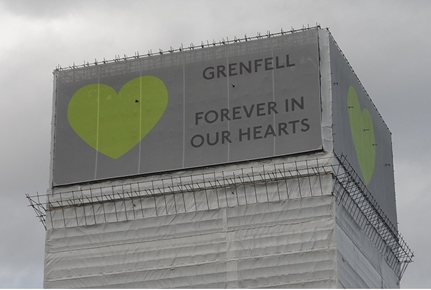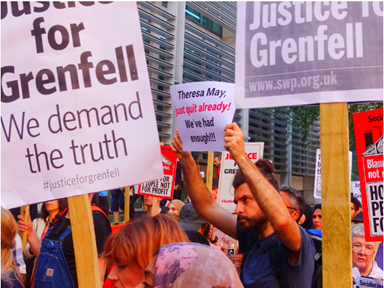Grenfell Tower Inquiry 2024: A Report on a System That Never Learns
The publication of the final report of the Grenfell Tower Inquiry on 4th September 2024 constituted a grim milestone in the UK's history of preventable tragedies. This exhaustive 1,700-page document catalogues not just the catastrophic failings that led to the Grenfell Tower fire on 14th June 2017—a fire that took 72 lives—but also sharply criticises systemic, regulatory, and corporate shortcomings that even today place public safety at risk.
But as the dust settles on this latest inquiry, like so many others with promises of reform, one wonders: when do we stop the post-mortems on disasters that never had to happen, and start taking preventive action?

Photo by Carcharoth, CC BY-SA 4.0, via Wikimedia Commons
Systemic Failures: The Unchanging Architecture of Neglect
Perhaps most damning of all, the report reveals the utter systemic failure across the board, from building regulations to fire safety standards. The cladding on Grenfell Tower, identified as the principal accelerant in the fire, was not just one moment of bad judgement but a catastrophic error embedded in outdated regulation and lax oversight. The report criticises the government and regulatory bodies for allowing dangerous cladding materials to be used. It states that “serious and longstanding failings” allowed highly flammable cladding and insulation to be installed on the tower.
The cladding was highly flammable—a fact that was either ignored or swept under the rug in the mad scramble for cost-cutting. The UK's building regulations, last significantly updated decades ago, have failed to keep pace with modern construction materials and methods, showing a regulatory framework more interested in appearances than in protecting lives.
The recommendations of this report are nothing new, with calls for stricter building regulations and an independent regulatory body to oversee building safety. Same old, same old—rehashed ideas after every catastrophe, whether from Grenfell, Lakanal House, or other low-publicity tragedies.
It’s depressingly predictable: a disaster occurs, a report is published, lofty promises of reform are made, and then… nothing changes. That these recommendations are being made all over again proves the system is not just broken—it’s designed to stay broken.
Corporate Misconduct: Profits Over People
The findings of corporate wrongdoing reveal the moral bankruptcy at the heart of the construction and refurbishment industries. Many firms involved in the Grenfell refurbishment misled the market about the safety of their products, prioritising profit margins over human life. Companies like Arconic, Kingspan, and Celotex were found to have engaged in “deliberate and sustained strategies to manipulate the testing processes, misrepresent test data, and mislead the market”.
The report pulls no punches in accusing these companies of deceit, yet penalties remain wholly insufficient for such wrongdoing. The call for much stiffer penalties on companies that flout safety regulations is, in fact, a lukewarm response to what amounts to corporate manslaughter. What are needed are not token fines that can be easily absorbed but actual punitive measures, including criminal charges, to serve as deterrents to such recklessness in the future.
It has long ceased to be sufficient to call for greater transparency and tighter regulation. There needs to be a cultural change in the industry, placing the value of human life above shareholder dividends. The recommendation for an independent regulatory body is admirable, but without real powers—without the authority to compel compliance and impose serious penalties—it will almost certainly turn into yet another impotent watchdog in a long line of bureaucratic failures.
Oversight and Regulation: A Legacy of Complacency and Neglect
The Grenfell Tower Inquiry’s final report pulls no punches in its condemnation of regulatory oversight. It reveals a chilling portrait of systemic complacency and institutional negligence that allowed Grenfell’s tragedy to unfold. The Royal Borough of Kensington and Chelsea, along with the building control departments, exhibited a shocking dereliction of duty, failing to enforce even the most basic safety standards. The disastrous decisions—such as the approval of highly flammable cladding—were not isolated errors but the culmination of a regulatory framework hollowed out by deregulation and cost-cutting, prioritising aesthetics, and budgets over human lives.
The findings make clear that these failures were not just procedural slip-ups but deep-rooted issues reflecting a system that failed to act on glaring dangers. That the report recommends basic safety measures—such as stricter enforcement of building codes and independent oversight—underscores how alarmingly low the bar has fallen. A complete overhaul of the regulatory environment is urgently required, one that finally places public safety above political expedience and profit margins.
Emergency Response: A Catastrophic Collapse of Judgement
The report’s critique of the emergency response on the night of the Grenfell fire is no less damning. The London Fire Brigade’s handling of the crisis was marked by critical delays, communication failures, and a rigid adherence to outdated protocols. The advice to residents to “stay put”, intended for fires confined within individual flats, became a tragic death sentence as the fire tore through the building’s exterior cladding. This wasn’t just a failure of procedure but a catastrophic lapse of judgement and leadership in the face of obvious and escalating danger.
The inquiry details how muddled leadership, ineffective communication, and a lack of real-time information led to life-and-death decisions that went disastrously wrong. Outdated protocols and a paralysed response further compounded the disaster, reflecting a service overwhelmed and unprepared for the scale of the crisis. While the report calls for improved training and updated evacuation procedures, these are merely the baseline expectations.
What’s needed is a radical transformation of emergency preparedness, replacing static advice like “stay put” with dynamic, evidence-based strategies that can adapt to rapidly changing circumstances. Without such fundamental change, the response to Grenfell risks being yet another chapter in a history of institutional failure.
Accountability: The Buck Stops Nowhere
Perhaps most galling in the final report from the Grenfell Tower Inquiry is the complete lack of clear accountability. It calls for greater corporate accountability, even hinting at possible criminal charges, but if history is a guide, any meaningful prosecution is unlikely. The names of those truly responsible—whether corporate executives, regulatory officials, or government heads—are conspicuously absent. Calls for regulatory overhaul and better oversight, without accountability, are destined to be shelved along with countless others.
The findings and conclusions of this inquiry reveal a culture of evasion where blame is diffused across various entities, none of which will truly face the music. While clear negligence and misconduct are documented, the report stops short of identifying those whose decisions and actions directly led to the disaster. Without targeted accountability, there is no deterrence for negligence that could lead to a similar tragedy.
Furthermore, the government's promise to “carefully consider" the recommendations of the report comes off as an empty gesture—heard as a platitude at best—deeply out of touch with the deep-seated rot at the heart of this system. What is needed is not mere consideration, but bold action—immediate, decisive action—underpinned by the full force of the law and a moral commitment to change.
By failing to identify, let alone prosecute, those responsible, these recommendations risk becoming yet another series of well-intended but ultimately hollow reforms. We should remember the 72 lives lost in Grenfell with nothing less than a demand for not just answers, but accountability; not just recommendations, but real reform.

Image courtesy of Gerry Popplestone (Creative Commons)
A Call to Action
The tragedy at Grenfell Tower was not an isolated incident but the predictable consequence of a system that prioritises profits over people, bureaucracy over action, and complacency over vigilance. The final report is not just a post-mortem on the fire; it is an indictment of a society that repeatedly fails to protect its most vulnerable citizens.
It is time now to cease the endless inquiries and recommendations and take bold, concrete steps to ensure that such a disaster can never happen again. This is not merely about buildings or regulations; it is about addressing a fundamental failure to care. The lessons of Grenfell will not have been learned, and the promises of change not fulfilled, until human life is prioritised above all else.
Further Reading:
Sharon Hartles published an article on the British Society of Criminology blog that may be of interest: The Grenfell 72 – Two Years On: Remember the dead and fight for the living!
Sharon Hartles, Member of the Harm and Evidence Research Collaborative, The Open University. Member of the British Society of Criminology. Affiliated with the Risky Hormones research project (an international collaboration in partnership with patient groups). Contact: sh28739@ou.ac.uk
